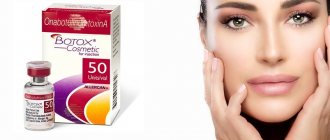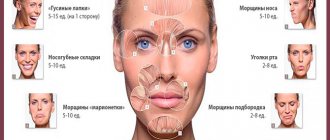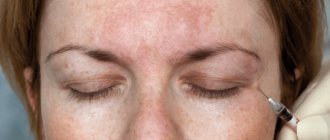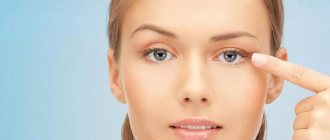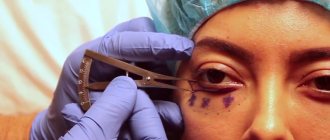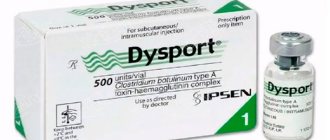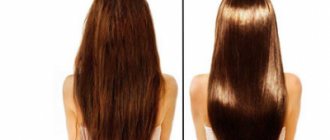The composition of Botox preparations and the effect of the components on the body
The main active component of Botox and similar products used in cosmetology is botulinum toxin type A. It is a poison of organic origin, but in minimal quantities, when injected under the skin, it causes relaxation - muscle relaxation.
That is, by blocking the passage of nerve impulses, it prevents the contraction of muscle fibers, and the skin in this area is smoothed out.
A number of people have increased susceptibility to even minimal amounts of botulinum toxin, which is manifested by muscle paralysis in the area of action of the drug.
However, this complication is not considered an allergy; there is no proven evidence that Botox-based drugs can cause a specific reaction in the immune system.
But allergies to Botox injections still happen and the reasons for its occurrence are the auxiliary components included in the products used for botulinum therapy in cosmetology.
These include:
- PROTEIN ALBUMIN (HUMAN). Contained in Botox, as well as Botulax and Relatox;
- LACTOSE AND ALBUMIN. They are components of the drug Dysport;
- SUGAROSE. Contained in Xeomin, Lantox, Refinex.
Albumin, lactose and sucrose can provoke the development of allergies in those people whose bodies are hypersensitive to them.
Typically, allergic reactions to Botox are not very pronounced in terms of symptoms and are easily tolerated. But allergies negatively affect the results of a cosmetic procedure and worsen your well-being.
Allergies are sometimes caused by improper dilution of botulinum toxin. Before injection, Botox preparations should be diluted with 0.9% sodium chloride according to the instructions. This is a physiological solution that is completely compatible with the internal environment of the body, it is well absorbed and does not cause changes in the functioning of the immune system.
However, some unqualified cosmetologists add lidocaine to Botox products in order to reduce pain sensitivity when giving injections.
This is a local anesthetic, to which allergies very often develop, and sometimes it occurs as anaphylactic shock or Quincke's edema, that is, severe reactions requiring emergency medical assistance.
An allergy to Botox can also be caused by the anesthetic cream that is applied to the face before the injections. It most often contains lidocaine or another painkiller.
That is, allergies to drugs containing Botox do happen. But the main reason for its development is auxiliary substances and anesthetics used to reduce pain during the session.
Complications after Botox injection
As already mentioned, at first Botox has an adverse effect on the eyes - this is the main negative consequence of botulinum therapy. It appears immediately after the injection is given. Injections have a bad effect on the organs of vision because they are often injected into the area between the eyebrow folds and the outer corners of the organ of vision.
So, the side effects of Botox are as follows:
- temporary visual impairment (double vision, deterioration of visual acuity);
- ptosis (dropping of the upper eyelid);
- dry eyes.
Due to the fact that the negative effect of Botox injections on the eyes is due to muscle relaxation, it is important to follow the cosmetologist’s instructions and not overdo it with the frequency of such procedures.
In this case, the duration of side effects will be short-lived. Speaking about whether it is worth using Botox for skin rejuvenation, I note that such injections are safe and effective, however, to achieve the desired result, this task should be entrusted to a highly qualified cosmetologist.
Read on the topic: What is the best way to treat moderate myopia in children?
Causes and methods of diagnosis
A professional cosmetologist who values his reputation will not give Botox injections immediately when a patient requests a service. First of all, the doctor determines the indications and contraindications for botulinum therapy, finds out whether there have been cases of allergic reactions in the past and to what, whether Botox was previously administered and how the body reacted to the drug.
A simple skin test, which can be performed in almost any cosmetology salon, helps to accurately determine the possible development of an allergy to products containing botulinum toxin:
- A small cut in the form of a scratch is made on the clean skin of the wrist. 2-3 drops of the Botox preparation chosen for the correction of wrinkles are dripped into it;
- Changes in the skin are assessed within an hour. With increased hypersensitivity, swelling and hyperemia, rash and itching appear at the injection site.
If an allergy is confirmed by a skin test, similar tests are carried out for other drugs with a neurotoxin. This makes it possible to understand exactly what irritant the body reacts to with hypersensitivity, which subsequently helps to select a harmless agent for botulinum therapy.
Testing for the possible occurrence of allergies when Botox is injected under the skin is not always considered a mandatory procedure, since there are not many real cases of an allergic reaction to botulinum toxin.
But this test must be carried out in cases where:
- There has been a history of hypersensitivity reactions to injectable drugs, especially anesthetics;
- The patient is prone to allergies of any type.
POPULAR WITH READERS: Allergy to penicillin, symptoms, treatment methods
Cosmetologists cannot refuse a test for sensitivity to Botox, and if the client himself wishes to conduct testing before the procedure. Therefore, for safety reasons and if you have doubts about the capabilities of your body, it is advisable to always undergo a sensitivity test before botulinum therapy; this will save you from many problems.
In addition, we should not forget that there are contraindications in which the administration of Botox even in minimal doses is not advisable.
These include:
- All trimesters of pregnancy and breastfeeding;
- Infectious diseases;
- Malignant processes in the body;
- The patient's age is under 18 years;
- Epilepsy and hemophilia;
- The period of treatment with antibiotics, sedatives, anticonvulsants and medications that affect the blood coagulation system. At least 2 weeks must pass from the last time you took these medications to the botulinum toxin injection procedure;
- Dermatitis.
With the above conditions and diseases, the functioning of the immune system deteriorates, hormonal levels and the course of metabolic reactions change, which can give rise to the occurrence of hypersensitivity.
Botox injections are not recommended for people over 45 years of age. The thing is that with age, muscles naturally relax and neurotoxin can worsen this condition, which negatively affects the cosmetic effect.
Antidepressants
Antidepressants (ADs) are used not only in the treatment of depression and anxiety, but also for any chronic pain syndrome, sleep disorders, chronic dizziness and to eliminate other psychosomatics.
Epidemiological studies indicate common pathways for the development of depression and chronic tension-type headache (CTTH). Therefore, if migraine, tension headaches, excessive headaches resulting from uncontrolled use of pharmaceuticals, and other types of headaches are detected, the doctor may prescribe the patient to take antidepressants. Thus, fluoxetine (Prozac) has proven itself positive in the treatment of chronic migraine and chronic headache. According to Ph.D. A.M. Veina and prof., d.m.s. T.G. Voznesenskaya, the effectiveness of therapy with this drug was noted in 65% of patients. Prozac has been shown to reduce the frequency and duration of seizures.
The group of tricyclic antidepressants (imipramine, amitriptyline, clomipramine) in the treatment of headaches leads to an analgesic (painkiller) effect by the end of the first week of taking the drugs, and in the 2-3rd week, as a result of the psychotropic effect, mood improves, the state of anticipation of spasms disappears and performance increases .
After several months of such therapy, antidepressants are gradually discontinued. There is no pharmacological dependence on antidepressants, only an individual, psychological one.
Modern ADs have virtually no side effects, but their use is undesirable in childhood and very old age, especially in combination with significant somatic pathology (diabetes mellitus, renal failure, liver failure, etc.). In such cases, the risks must always be assessed.
Contraindications for taking antidepressants:
- pregnancy;
- lactation;
- convulsive syndrome;
- simultaneous use of MAO inhibitors;
- severe pathologies of the liver and kidneys.
Symptoms
If you are intolerant to the components of drugs containing botulinum toxin, the allergy manifests itself both as local changes in the injection area and as general symptoms.
The following signs are characteristic of a local allergic reaction:
- Skin hyperemia at the site of Botox;
- Increasing swelling, sometimes painful;
- Temperature increase. Most often, hyperemia concerns the injection area, but it can also be general;
- Discomfortable sensations in the area of the eyes, lips, eyebrows, eyelids, that is, where Botox was injected;
- Problems with swallowing;
- Itching of the skin in the injection area, less often throughout the body;
- Dysarthria – deterioration in the pronunciation of sounds or individual words;
- Peeling of the skin.
The first manifestations of allergies usually begin 10-20 minutes after Botox injections. However, clear symptoms in most cases appear several hours and even days after the procedure.
The symptoms listed above do not always indicate an allergy. Swelling and redness are most often a consequence of injury to the epidermis and subcutaneous layers by an injection.
Deterioration in swallowing, pronunciation of sounds and changes in muscle activity can occur with increased absorption of botulinum toxin into the body. Therefore, it is impossible to independently determine whether there is an allergy or not. This should be done by a cosmetologist after examination.
Systemic allergic reactions to neurotoxin (anaphylaxis, angioedema) occur significantly less frequently compared to local allergies. But they are much more dangerous and the first symptoms can be noticed even at the stage of introducing Botox into the skin:
- The face begins to swell quickly;
- There is a strong lack of air;
- Trembling appears in the arms, legs and throughout the body;
- Heart rate increases;
- Sticky, cold sweat appears on the body;
- The pressure drops;
- Consciousness becomes stunned and inhibited.
In case of such manifestations of allergies, the procedure is stopped and the patient is given anti-shock drugs. After stabilizing his health, he should remain under the supervision of a medical professional for some time.
Treatment
If local symptoms of an allergy to Botox are mild, there is no need to worry too much. But it is important to make sure that this is really hypersensitivity and not another complication, so contact your cosmetologist for clarification.
An allergic reaction can be controlled by taking antihistamines in tablets, such as:
- Loratadine;
- Erius;
- Claritin;
- Peritol;
- Trexil;
- Other allergy medications.
With increasing swelling, it is better to take Suprastin. This drug quickly stops the development of allergies and prevents an increase in the symptoms of the pathology. After this, you should definitely consult a doctor.
With Quincke's edema and anaphylactic shock, the patient needs emergency care. If your health deteriorates in the clinic, the cosmetologist should:
- Apply ice to the injection site;
- Give antihistamines in injections - Suprastin, Diphenhydramine;
- In case of shock and a drop in blood pressure, inject Prednisolone or Dexamethasone into a vein;
- Provide fresh air flow.
In beauty salons that administer beauty injections there should be an emergency first aid kit. Using the medications included in it, an experienced doctor will always be able to provide immediate assistance if you are allergic to Botox.
If a cosmetologist cannot cope with the relief of anaphylaxis on his own, then he must call a resuscitation team to the clinic.
Preventive actions
The main therapeutic effects of botulinum toxin and drugs based on it have been well studied. But studies that would establish the frequency of development of allergies to neurotoxin have not yet been conducted.
POPULAR WITH READERS: What to do if your eyes itch due to allergies?
Therefore, when choosing a method for correcting wrinkles using Botox and its analogues, cosmetologists give recommendations only those that are determined based on practice:
- Individual hypersensitivity to the components of drugs containing botulinum toxin occurs extremely rarely, and even less often an allergy actually threatens health. Based on this, specific prevention of the development of an allergic reaction is not required for patients with no history of allergy;
- Before a botulinum therapy session, you need to make sure that there is no hypersensitivity to the anesthetic. You can ask the cosmetologist to use those types of anesthesia in which the conditionally dangerous Lidocaine is not used;
- In case of intolerance to Botox, recorded in the past, even if we are talking about minimal manifestations of allergies, further injections should be abandoned until the causative allergen is determined. You need to know that hypersensitivity increases over time - minor manifestations of an allergic reaction over time can turn into anaphylactic shock;
- The allergenic component can be determined by performing several skin tests. Having identified the allergen, you can already choose the safest product with botulinum toxin. For example, if you are lactose intolerant, you can use all medications except Dysport. If you are sensitive to albumin, you can use Xeomin or Lantox;
- The administration of Botox is completely abandoned if the allergy is a consequence of a specific immune reaction to botulinum toxin. In such cases, alternative methods help to cope with wrinkles on the face - fillers, hardware skin tightening.
Memo for the patient
An allergy to Botox and similar drugs is quite possible. In some cases, its development can be prevented, and when symptoms appear, they can be quickly relieved.
Before the procedure you must:
- Make sure your cosmetologist is highly qualified. An experienced doctor knows how to deal with allergic reactions, and his office has the necessary medications and tools;
- Set the expiration date for products containing botulinum toxin. You definitely need to study the composition of the drug; perhaps there was an unusual reaction to some of the components in the past. When in doubt, it is better to conduct a skin test;
- Clarify the method of diluting the neurotoxin. It is safest to mix the drug with saline. solution.
If you feel worse during a session, you should:
- Tell your doctor about any uncomfortable changes. The cosmetologist must interrupt the Botox administration, conduct an examination and diagnosis, and, if necessary, carry out treatment on the spot;
- Listen to the doctor's instructions. Panic leads to an intensification of the allergic reaction and prevents the doctor from choosing the right treatment tactics.
If you notice signs of an allergy to Botox at home:
- Get a face-to-face consultation with a doctor. If this is not possible in the near future, then you should report disturbing symptoms by phone, you can send a photo of your face;
- For minor allergy manifestations, you should take an antihistamine;
- If signs appear indicating the possible development of anaphylactic shock or Quincke's edema, you should immediately call an ambulance.
An allergy to Botox, especially a local one, is similar to complications that arise when the injection technique is violated, and may also be a consequence of the individual characteristics of the body.
In this regard, you should not engage in independent treatment. Only an experienced doctor can determine the main cause of the changes and, based on this, select adequate therapy.
Reasons why headaches occur after Botox injections
After Botox injections in the forehead, headaches develop for the following reasons:
- violation of the recommendations prescribed by the cosmetologist;
- individual reaction of the body;
- skin injury.
Headache that develops after injections in the forehead does not pose a threat to the patient’s health and is a common side effect.
Reaction to skin trauma. The facial muscles fit tightly to the skin, and even an experienced doctor, if all the rules are followed, can touch the frontal bone with a needle. Accidental puncture of the vessel leads to contact of the drug with the inner layer of the capillaries. In addition, microtrauma caused by a needle during injection often leads to short-term inflammation affecting nerve fibers. All these factors can cause intense and local pain in the head, which goes away on its own after 2-3 days.
Muscle strain. Elimination of wrinkles in the area between the eyebrows and forehead involves temporary paralysis of muscle fibers, the action of which is aimed at holding the eyelids. As the dosage increases, the tissues of the forehead and eyelids lose support, sagging occurs, which creates heaviness and tension in this area. To return to the original state, you have to intensely strain the active muscles, which in most cases causes a headache. When comparing the sensations with the previous cause, in this case they are more intense and strong, reaching into the eyes. Headache may accompany the patient for several weeks until muscle adaptation occurs.
The body's reaction. Headaches for this reason rarely develop and manifest themselves in unpleasant sensations at the site of skin puncture, general malaise, pain of varying localization and strength, and increased pressure. In this case, the pain may not be caused by the tulinum toxin, but by the anesthetic used. If such symptoms appear, you should contact a cosmetologist who, based on the identified condition, will draw up a treatment plan.
Violation of the rules of the recovery period. In the first two weeks after the procedure, the cosmetologist gives recommendations that will help not only prolong the results of Botox, but also reduce the risk of complications. During the rehabilitation period, any alcohol, antibiotics, heat exposure and physical activity should be avoided. These recommendations make it possible to create conditions for uniform distribution of the toxin in tissues, as well as to prevent spread to neighboring ones. If the advice is ignored, the patient experiences bruising, drooping of the upper eyelid, headaches and lack of effect.
